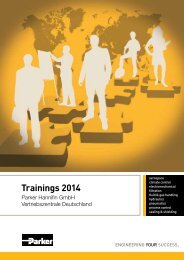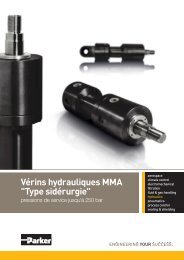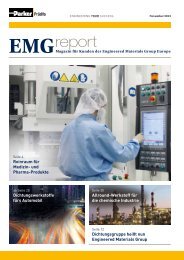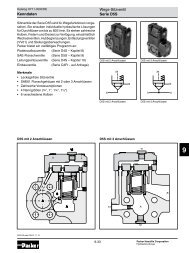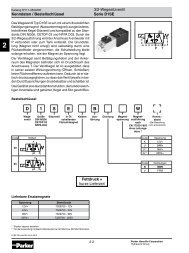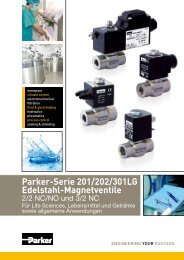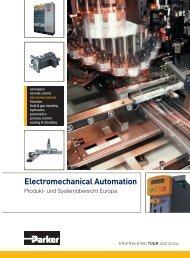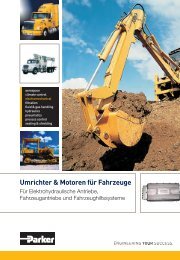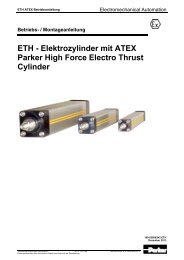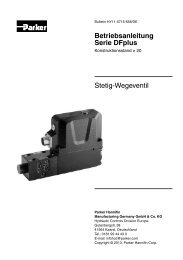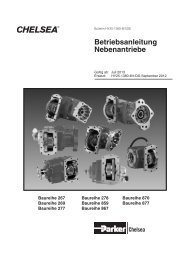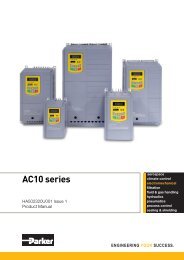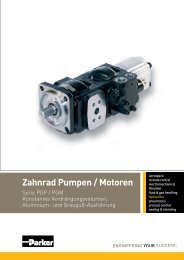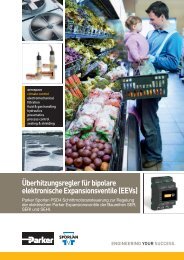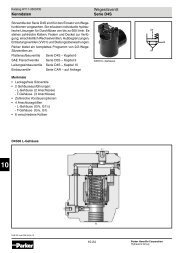L50 Injection Lubricator - Parker
L50 Injection Lubricator - Parker
L50 Injection Lubricator - Parker
Create successful ePaper yourself
Turn your PDF publications into a flip-book with our unique Google optimized e-Paper software.
Pneumatic Division<br />
Richland, Michigan 49083<br />
269-629-5000<br />
PDNSG-1<br />
Pneumatic Division Safety Guide<br />
ISSUED: August 1 , 2006<br />
Supersedes: June 1, 2006<br />
Safety Guide For Selecting And Using Pneumatic Division Products And Related Accessories<br />
! WARNING:<br />
FAILURE OR IMPROPER SELECTION OR IMPROPER USE OF PNEUMATIC DIVISION PRODUCTS, ASSEMBLIES OR RELATED<br />
ITEMS (“PRODUCTS”) CAN CAUSE DEATH, PERSONAL INJURY, AND PROPERTY DAMAGE. POSSIBLE CONSEQUENCES<br />
OF FAILURE OR IMPROPER SELECTION OR IMPROPER USE OF THESE PRODUCTS INCLUDE BUT ARE NOT LIMITED TO:<br />
• Unintended or mistimed cycling or motion of machine members or failure to cycle<br />
• Work pieces or component parts being thrown off at high speeds.<br />
• Failure of a device to function properly for example, failure to clamp or unclamp an associated item or device.<br />
• Explosion<br />
• Suddenly moving or falling objects.<br />
• Release of toxic or otherwise injurious liquids or gasses.<br />
Before selecting or using any of these Products, it is important that you read and follow the instructions below.<br />
1. GENERAL INSTRUCTIONS<br />
1.1. Scope: This safety guide is designed to cover general guidelines on the installation, use, and maintenance of Pneumatic Division<br />
Valves, FRLs (Filters, Pressure Regulators, and <strong>Lubricator</strong>s), Vacuum products and related accessory components.<br />
1.2. Fail-Safe: Valves, FRLs, Vacuum products and their related components can and do fail without warning for many reasons. Design all<br />
systems and equipment in a fail-safe mode, so that failure of associated valves, FRLs or Vacuum products will not endanger persons<br />
or property.<br />
1.3 Relevant International Standards: For a good guide to the application of a broad spectrum of pneumatic fluid power devices see:<br />
ISO 4414:1998, Pneumatic Fluid Power – General Rules Relating to Systems. See www.iso.org for ordering information.<br />
1.4. Distribution: Provide a copy of this safety guide to each person that is responsible for selection, installation, or use of Valves, FRLs<br />
or Vacuum products. Do not select, or use <strong>Parker</strong> valves, FRLs or vacuum products without thoroughly reading and understanding this<br />
safety guide as well as the specific <strong>Parker</strong> publications for the products considered or selected.<br />
1.5. User Responsibility: Due to the wide variety of operating conditions and applications for valves, FRLs, and vacuum products <strong>Parker</strong><br />
and its distributors do not represent or warrant that any particular valve, FRL or vacuum product is suitable for any specific end use<br />
system. This safety guide does not analyze all technical parameters that must be considered in selecting a product. The user, through<br />
its own analysis and testing, is solely responsible for:<br />
• Making the final selection of the appropriate valve, FRL, Vacuum component, or accessory.<br />
• Assuring that all user’s performance, endurance, maintenance, safety, and warning requirements are met and that the application<br />
presents no health or safety hazards.<br />
• Complying with all existing warning labels and / or providing all appropriate health and safety warnings on the equipment on which<br />
the valves, FRLs or Vacuum products are used; and,<br />
• Assuring compliance with all applicable government and industry standards.<br />
1.6. Safety Devices: Safety devices should not be removed, or defeated.<br />
1.7. Warning Labels: Warning labels should not be removed, painted over or otherwise obscured.<br />
1.8. Additional Questions: Call the appropriate <strong>Parker</strong> technical service department if you have any questions or require any additional<br />
information. See the <strong>Parker</strong> publication for the product being considered or used, or call 1-800-CPARKER, or go to www.parker.com,<br />
for telephone numbers of the appropriate technical service department.<br />
2. PRODUCT SELECTION INSTRUCTIONS<br />
2.1. Flow Rate: The flow rate requirements of a system are frequently the primary consideration when designing any pneumatic system.<br />
System components need to be able to provide adequate flow and pressure for the desired application.<br />
2.2. Pressure Rating: Never exceed the rated pressure of a product. Consult product labeling, Pneumatic Division catalogs or the<br />
instruction sheets supplied for maximum pressure ratings.<br />
2.3. Temperature Rating: Never exceed the temperature rating of a product. Excessive heat can shorten the life expectancy of a product<br />
and result in complete product failure.<br />
2.4. Environment: Many environmental conditions can affect the integrity and suitability of a product for a given application. Pneumatic<br />
Division products are designed for use in general purpose industrial applications. If these products are to be used in unusual<br />
circumstances such as direct sunlight and/or corrosive or caustic environments, such use can shorten the useful life and lead to<br />
premature failure of a product.<br />
2.5. Lubrication and Compressor Carryover: Some modern synthetic oils can and will attack nitrile seals. If there is any possibility of<br />
synthetic oils or greases migrating into the pneumatic components check for compatibility with the seal materials used. Consult the<br />
factory or product literature for materials of construction.<br />
2.6. Polycarbonate Bowls and Sight Glasses: To avoid potential polycarbonate bowl failures:<br />
• Do not locate polycarbonate bowls or sight glasses in areas where they could be subject to direct sunlight, impact blow, or<br />
temperatures outside of the rated range.<br />
• Do not expose or clean polycarbonate bowls with detergents, chlorinated hydro-carbons, keytones, esters or certain alcohols.<br />
• Do not use polycarbonate bowls or sight glasses in air systems where compressors are lubricated with fire resistant fluids such as<br />
phosphate ester and di-ester lubricants.<br />
PDNSG-1



